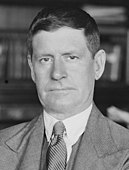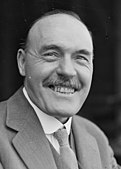| ||||||||||||||||||||||||||||||||||
All 90 seats in the New South Wales Legislative Assembly 46 Assembly seats were needed for a majority | ||||||||||||||||||||||||||||||||||
|---|---|---|---|---|---|---|---|---|---|---|---|---|---|---|---|---|---|---|---|---|---|---|---|---|---|---|---|---|---|---|---|---|---|---|
| ||||||||||||||||||||||||||||||||||
 Two-candidate-preferred margin by electorate | ||||||||||||||||||||||||||||||||||
| ||||||||||||||||||||||||||||||||||
The 1927 New South Wales state election to elect the 90 members of the 28th Legislative Assembly was held on 8 October 1927. During the previous parliament the voting system, Single transferable voting, a form of proportional representation with multi-member seats (modified Hare-Clark), had been changed to single member constituencies and Instant-runoff voting (optional preferential voting).[1][2][3]
Severe divisions occurred within the Labor Party caucus in the four months prior to the election (see Lang Labor). A caretaker government composed of the supporters of the Premier of New South Wales and party leader, Jack Lang was in power at the time of the election.[4]
As a result of the election the Lang government was defeated and a Nationalist/Country Party coalition government led by Thomas Bavin[5] and Ernest Buttenshaw[6] was formed with a parliamentary majority of 1 and the usual support of the 2 Nationalist independents. The Parliament first met on 3 November 1927, and ran its maximum term of 3 years. Lang remained the leader of the Labor Party throughout the Parliament.
To date Lang is the only elected Labor Premier of New South Wales to be voted out of office. Subsequent Labor Premiers who has lost office were all non-elected.
- ^ Cite error: The named reference
Green 1927was invoked but never defined (see the help page). - ^ "Part 5B alphabetical list of all electorates and Members since 1856" (PDF). NSW Parliamentary Record. Parliament of New South Wales. Retrieved 20 April 2020.
- ^ "Former members of the New South Wales Parliament, 1856–2006". New South Wales Parliament. Retrieved 4 December 2019.
- ^ Nairn, Bede. "Lang, John Thomas (Jack) (1876–1975)". Australian Dictionary of Biography. Canberra: National Centre of Biography, Australian National University. ISBN 978-0-522-84459-7. ISSN 1833-7538. OCLC 70677943. Retrieved 2 November 2021.
- ^ McCarthy, John. "Bavin, Sir Thomas Rainsford (Tom) (1874–1941)". Australian Dictionary of Biography. Canberra: National Centre of Biography, Australian National University. ISBN 978-0-522-84459-7. ISSN 1833-7538. OCLC 70677943. Retrieved 6 May 2019.
- ^ Kingston, Beverley. "Buttenshaw, Ernest Albert (1876–1950)". Australian Dictionary of Biography. Canberra: National Centre of Biography, Australian National University. ISBN 978-0-522-84459-7. ISSN 1833-7538. OCLC 70677943. Retrieved 23 November 2021.


